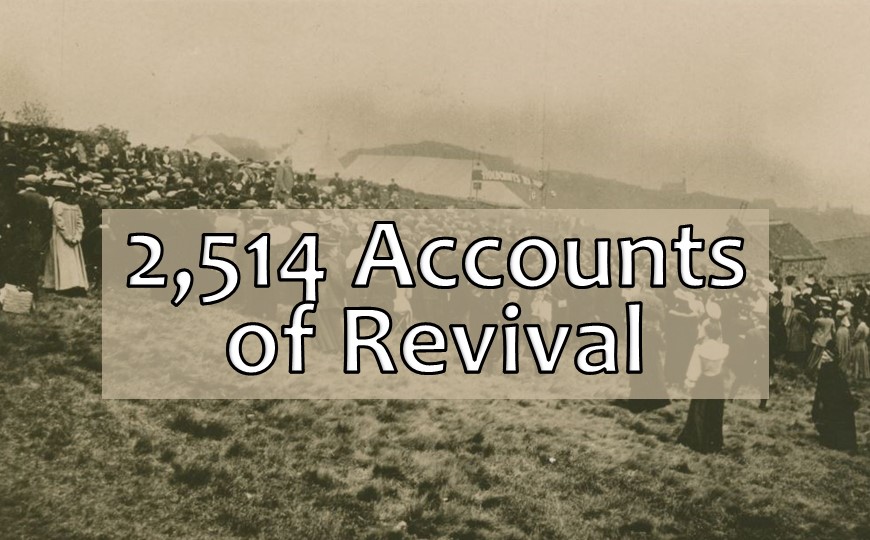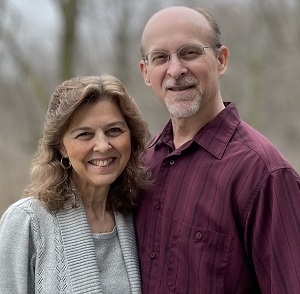2,514 Accounts of Revival


Chet & Phyllis Swearingen
Missionaries & Revivalists
We have researched and written the accounts of revivals below in an abbreviated form. We believe our work is unique because it includes numerous pictures, maps, and many hyperlinks for those seeking additional information.
How the Stories are Being Used
► They are being translated into many different languages.
► Bible Colleges are using them to teach from, as well as using them for quick reference materials.
► Pastors are using them for sermon illustrations.
► Intercessors read them while praying for revival.
► Daily Devotions: Some read them devotionally.
May the Lord use these accounts to awaken a hunger in your heart for revival within yourself, your church, and your community!
Biblical Revivals
1372 B.C. Revival Under Joshua
1374 B.C. Revivals in the Book of Judges (8 revivals)
1074 B.C. Revival Under Samuel
916 B.C. Revival Under King Asa
870 B.C. Revival Under Jehoshaphat
767 B.C. Revival at Nineveh Under Jonah
727 B.C. Revival Under King Hezekiah
623 B.C. Revival Under King Josiah
521 B.C. Revival Under Zerubbabel, Haggai, and Zechariah
432 B.C. Revival Under Nehemiah
26 A.D. Revival Under John the Baptist
27 A.D. Revival Under Jesus and His Disciples
27 A.D. Revival in the Samaritan Village of Sychar
30 A.D. Revival on the Day of Pentecost
31 A.D. Revival in Samaria Under Philip
37 A.D. Revival in Caesarea Under Peter
48 A.D. Revivals During Paul’s 1st Missionary Journey
49 A.D. Revivals During Paul’s 2nd Missionary Journey
53-57 A.D. Revivals During Paul’s 3rd Missionary Journey
Protestant Reformation
The Need for the Protestant Reformation
1170s Waldensian Pre-Protestant Reformation Attempt in France
1200s Franciscan Reformation Attempt in Italy
1382 John Wycliffe and the Lollard’s Reformation Attempt in England
1415 John Hus & the Hussite Reformation Attempt in Czech
1481 Girolamo Savonarola Reformation Attempt in Florence, Italy
1517 Martin Luther and the Protestant Reformation in Germany
1520s Ulrich Zwingli and the Switzerland Reformation
1541 John Calvin and the Geneva Switzerland Reformation
1540s John Knox and the Scottish and English Reformation
Awakenings, Revivals, Outpourings
1625 Stewarton Revival (Irvine)
1700s Welsh Methodist Revival (8 revivals)
1708 Silesian Children’s Prayer Revival (5 revivals)
1727 Moravian Revival (Expanded Version)
1730s-1740s 1st Great Awakening (100+ revivals)
1738-1791 The British Great Awakening
1738 New Jersey and Pennsylvania Revivals (5 revivals)
1740 Boston Revival (27 revivals)
1742 Cambuslang, Scotland Revival (6+ revivals)
1742 Kilsyth, Scotland Revival
1742 Baldernock, Scotland Revival (22+ revivals)
1743 Virginia Revivals (6 revivals)
1745 Revival – Delaware Indians
1748 Revival Among Virginia’s Enslaved
1758 Ministry Among Native Americans
1781 Cornwall’s Christmas Prayer Revival (9 revivals)
1790-1840 2nd Great Awakening (150+ revivals)
1791 Bala Revival (3 revivals)
1797 New England Revivals (150+ revivals)
1800s United Brethren Revivals
1801-1802 North Carolina Revivals (10 revivals)
1801 Cane Ridge Revival (10 revivals)
1802 Yale College Revivals (4 revivals)
1804 Revival on the Isle of Arran (2 revivals)
1809 Middlebury, Vermont Revival (5 revivals)
1809 Demerara Revival (Guyana)
1809 Vermont Revivals (7 revivals)
1812 Skye, Scotland Revivals (5 revivals)
1813-1847 Revivals in the Old South (6+ revivals)
1815 College of New Jersey Revival
1815-1840 Upstate New York Revivals (89 revivals)
1816-1818 Breadalbane, Scotland Revival (8 revivals)
1817-1822 Beddgelert, Wales Revival (4+ locations)
1820s-1830s Revival on the Island of Lewis (5 revivals)
1823 Filey Revival (66 locations)
1823-1824 Baltimore, Maryland Revival
1824 Evans Mills German Settlement (4 revivals)
1824 Antwerp, New York Revival
1824 Revival at Perch River and Other Locations
1825 Revival in De Kalb, New York (2 revivals)
1825 Western, New York Revival (5 revivals)
1825-1826 Revival in Rome, New York
1826 Revival in Oneida County (10 revivals)
1826-1827 Troy, New York Revival
1827 New Lebanon & Stephentown (2 revivals)
1827-1829 Revival at Wilmington and Philadelphia
1827-1841 New York & Canada (8 revivals)
1829 Reading, Pennsylvania Revival
1829 Lancaster, Pennsylvania Revival
1829 Columbia, New York Revival
1830-1831 Rochester, New York (5 revivals)
1831 Revivals in Auburn (4 revivals)
1832-2020 China’s Shandong Province Revivals
1835-1840 Revivals in Oberlin, Ohio
1836 Hawaiian Revival (2 revivals)
1839 Kilsyth Revival (55 revivals)
1841 Ireland Revivals (4 revivals)
1841-1842 Boston & Providence Revivals
1842 Liverpool, England Revival
1842-1843 Revivals in Oberlin, New York, and Boston
1844 Sheffield, England Revival
1844 Huddersfield, England Revival (20 revivals)
1847-1865 Revivals of James Caughey (11 revivals)
1849 Revivals in Houghton, England (7 revivals)
1850-1851 London, England Revival
1851-1853 Revivals in Oberlin, New York City, Hartford, & Syracuse
1853-1855 Revivals in Ohio & New York
1856-1858 Boston Revival (Third Great Awakening)
1857 Anson Street Revival (2 revivals)
1857 Hamilton, Ontario Revival (15 revivals)
1859 England Revival (5 revivals)
1859-1860 Scotland & England (4 revivals)
1859 Welsh Revival (27 revivals)
1859 Ulster, Ireland (20+ revivals)
1860 South Africa Revival (44 revivals)
1860-1868 Oberlin, Ohio Revivals
1860 Jamaican Revival (13 revivals)
1863 The Great Revival in the Confederate Armies
1865 Batak Revival
…• Bahasa Indonesia
1872 London Revival – D. L. Moody (27+ revivals)
1875 Gold Coast Revival (22 revivals)
1878 Garrettsville, Ohio Revival (R. A. Torrey – 4 revivals)
1879-1924 Revivals of Maria Woodworth-Etter (116+ revivals)
1880 St. Catharines, Ontario Revival
1896 Shearer Schoolhouse Revival
1896-1935 Billy Sunday Revivals (426+ revivals)
1897 Gilkes Street Revival, Middlesbrough, UK
1902 Melbourne, Australia Revival (R. A. Torrey)
1902 Revivals in Asia-Pacific (R. A. Torrey – 15 revivals)
1903-1905 Great Britain Revivals (R. A. Torrey – 14 revivals)
1903 Dongjia’an, China Revival
1904 Sialkot, India Revival (5+ revivals)
1904-05 Welsh Revival (146+ revivals)
1905 Charlotte Chapel Revival (32 revivals)
1905 Khasi Hills Revival (49 revivals)
1905 Mukti Revival (5 revivals)
1905 Revival at Dohnavur (2 revivals)
1905 India Revivals I (20 revivals)
1905 India Revivals II (8 revivals)
1905 India Revivals III (5 revivals)
1906 India Revivals IV (10 revivals)
1906 India Revivals V (8 revivals)
1906 India Revivals VI (8 revivals)
1905-1906 India Revivals VII (9 revivals)
1905-1906 India Revivals VIII (14 revivals)
1905-1906 Queensland Kanaka Revival (6+ revivals)
1906 India Revivals IX (8 revivals)
1906 Aurangabad, India Revival (5 revivals)
1906 Mizo, India Revival (13 revivals)
1908 Manchurian Revival (10+ revivals)
1908 Shansi, China Revival (6+ revivals)
1908-1909 China Revivals (6+ revivals)
1909 Chile Revival (4 revivals)
1915 Gazaland Revival (26 revivals)
1921 Fishermen’s Revival (32 revivals)
1927-1939 Chinese Awakening (10+ revivals)
1930s Pennsylvania Revivals (18 revivals)
1931 Nanchang, China (2 revivals)
1933 Lun Bawang Revival (2 Revivals)
1936 Ngaruawahia Easter Revival
1936 East African Revival (7 revivals)
1936 Solomon Islands Revival (3 revivals)
1936 & 1943 Wheaton College Revivals (2 revivals)
1948 Latter Rain Revival (7 revivals)
1949 Argentina Revival (13 revivals)
…• Portuguese
1949 Revival on the Island of Lewis (Hebrides)
1951 Lancaster, Pennsylvania Revival
1952-1976 Naga Revival (2 revivals)
1953 Congo Revival (8+ revivals)
1965 Kebangunan Rohani Timor (Bahasa Indonesia)
1965 Timor Revival
…• 1965 Controversy with the Timor Revival
1967 Catholic Charismatic Renewal
1969 Northeast Indiana Revival
1970 Asbury Revival
…• The “Spark” for the 1970 Asbury College Revival
…• What Can a Revival Look Like?
…• Two FREE books about the Asbury Revival
1970 Solomon Islands Revival (4+ revivals)
1973 Bario Revival (6 Revivals)
1974 Alomonga, Guatemala Revival
1979 Elcho Island Revival (52 revivals)
1979 USS Barry Revival
…• 1979 USS Barry Revival – Expanded Version
1984 Argentine Revival (23 revivals)
1985 Hemet, California Revival
1988 Cuban Revival (2 revivals)
1989 Anhui & Shandong Revivals (2 revivals)
1995 Brownwood, Texas Revival (50+ revivals)
1995 Howard Payne University Revival
1996 Inuit Revival (18 revivals)
1999 Mornington Island Revival (5 revivals)
2006 Shillong Revival (41 revivals)
Consider Supporting Beautiful Feet
If these stories are a blessing to you, please consider supporting our ministry, either with a one-time-gift or as a regular supporter. Donations will be used for our revival ministry in the USA as well as the ministry we are involved with overseas.
Donations can be made securely with this web-page.
Chet & Phyllis Swearingen:
Office: (260) 920-8248
romans1015@outlook.com
Beautiful Feet
P.O. Box 915
Auburn, IN 46706

